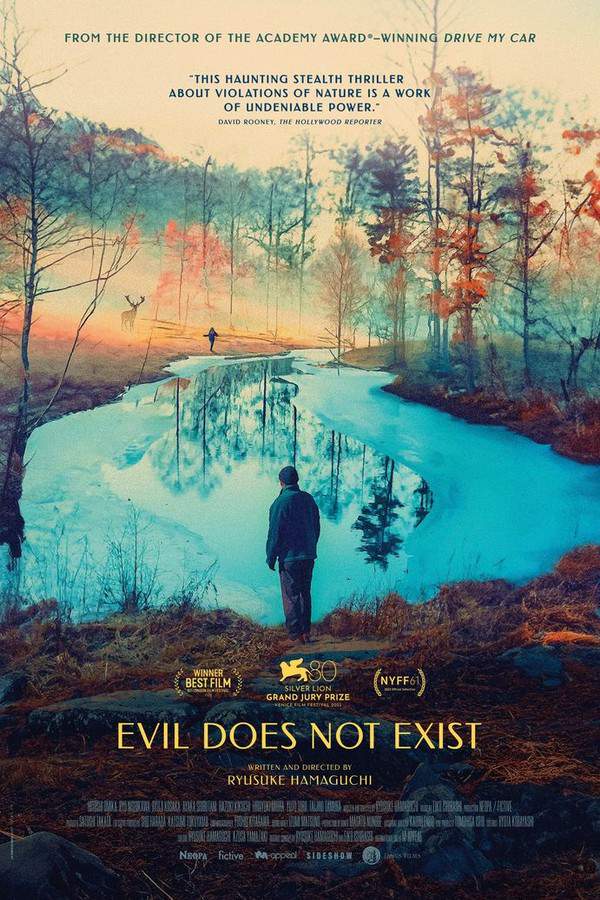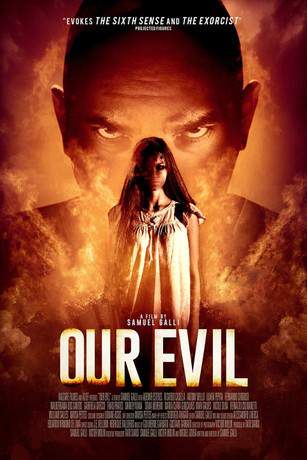Evil Does Not Exist 2024

Takumi and his daughter Hana live a peaceful life in the mountain village of Mizubiki, providing Tokyo with water, wood, and wasabi. Their tranquil existence is threatened when a luxurious glamping resort is planned for the area, potentially disrupting the natural beauty and serenity of their home.
Does Evil Does Not Exist have end credit scenes?
No!
Evil Does Not Exist does not have end credit scenes. You can leave when the credits roll.
Meet the Full Cast and Actors of Evil Does Not Exist
Explore the complete cast of Evil Does Not Exist, including both lead and supporting actors. Learn who plays each character, discover their past roles and achievements, and find out what makes this ensemble cast stand out in the world of film and television.
External Links and Streaming Options
Discover where to watch Evil Does Not Exist online, including streaming platforms, rental options, and official sources. Compare reviews, ratings, and in-depth movie information across sites like IMDb, TMDb, Wikipedia or Rotten Tomatoes.
Ratings and Reviews for Evil Does Not Exist
See how Evil Does Not Exist is rated across major platforms like IMDb, Metacritic, and TMDb. Compare audience scores and critic reviews to understand where Evil Does Not Exist stands among top-rated movies in its genre.

The Movie Echo Score
In its overall impression, Evil Does Not Exist excels in crafting an immersive mood even as its deliberate pace divides opinion. Critics and viewers alike praise the film’s meticulous visual compositions and atmospheric tone, but some find the narrative’s open-ended structure and measured pacing to hinder engagement. The film’s fusion of naturalistic detail with mythic undercurrents creates a compelling if occasionally elusive experience. Altogether, this balance of evocative style and interpretive ambiguity leaves a lasting, somber resonance.
The Movie Echo Score Breakdown for Evil Does Not Exist

Art & Craft
In terms of craft and visual design, the film stands out for its striking framing and deliberate camera movement. The direction emphasizes extended takes and careful compositions that highlight the natural environment. Production design feels authentic to rural settings, and editing unfolds at a measured pace. Overall, this visual precision establishes a strong, immersive aesthetic.

Character & Emotion
When it comes to character depth and emotional resonance, the performances convey subdued nuance more than heightened drama. Acting choices favor quiet introspection, with subtle gestures and minimal dialogue driving emotional moments. Chemistry among the small cast supports a reflective tone, though some viewers note difficulty connecting to a reticent protagonist. Nonetheless, the understated portrayal sustains consistent human interest.

Story & Flow
Regarding plot coherence and pacing, the narrative unfolds with a deliberate slowness that some find meditative while others deem it ponderous. The eco-parable structure offers thematic originality, yet the open-ended conclusion can feel oblique. Occasional lulls in momentum contrast with engaging mythic motifs. Ultimately, the story’s subtle design will reward patient viewers more than those seeking clarity.

Sensory Experience
When considering the sensory experience, the film excels in its auditory and visual cohesion. The score and natural sound design blend seamlessly with ambient forest noises, enriching each scene. A restrained color palette and thoughtful use of light create subtle mood shifts. Overall, the film’s layered sonic and visual elements deliver a deeply immersive atmosphere.

Rewatch Factor
In terms of rewatch value, the film’s evocative imagery and thematic ambiguity invite multiple viewings. Subtle details in framing and environmental motifs emerge more clearly on repeat watches. However, the leisurely pace may challenge some audiences again. Despite this, the lingering questions and nuanced symbolism encourage a deeper appreciation with each subsequent viewing.

83
Metascore
6.4
User Score


91%
TOMATOMETER

83%
User Score

/10
IMDb Rating

67
%
User Score

3.8
From 578 fan ratings

0.00/5
Take the Ultimate Evil Does Not Exist Movie Quiz
Challenge your knowledge of Evil Does Not Exist with this fun and interactive movie quiz. Test yourself on key plot points, iconic characters, hidden details, and memorable moments to see how well you really know the film.
Evil Does Not Exist Quiz: Test your knowledge of the movie 'Evil Does Not Exist'.
What is the setting for the opening scenes of the movie?
A bustling city
The tranquil winter forest of Mizubiki, Japan
A remote desert island
A snow-covered mountain range
Show hint
Full Plot Summary and Ending Explained for Evil Does Not Exist
Read the complete plot summary of Evil Does Not Exist, including all major events, twists, and the full ending explained in detail. Explore key characters, themes, hidden meanings, and everything you need to understand the story from beginning to end.
The tranquil expanse of Mizubiki’s winter forest creates a serene atmosphere as the story unfolds. At the heart of this narrative is Takumi, a widowed father navigating life with his spirited eight-year-old daughter, Hana. Their daily routine reflects the calmness of their rural Japanese village, occasionally disrupted by the distant sound of gunfire from deer hunting expeditions.
During a community meeting, tension fills the air as two representatives from a glamping development company, Takahashi and Mayuzumi, present their proposal to the skeptical townspeople. The polished veneer of their public relations pitch soon crumbles under the weight of residents’ genuine fears about the project’s potential impact on Mizubiki’s fragile water systems. Takumi, along with his community members, voices strong concerns regarding septic tank capacity, warning that it could lead to sewage contamination affecting their well-water supply.
Initially dismissive of the villagers’ worries, the representatives gradually begin to empathize as they truly listen to their plight. However, once they reestablish communication with their superior, they receive orders to sidestep the environmental concerns and instead aim to win over Takumi by lavishing him with gifts and offering him the role of caretaker for the glamping site. Back in Mizubiki, Takahashi and Mayuzumi share amusing stories of their own online dating misadventures, revealing their disillusionment with their corporate job.
As they adapt to village life, Takahashi decides to abandon his fast-paced urban existence, choosing instead to embrace local culture and seek guidance from Takumi. One day during a scenic drive, Takumi warns him with a tale about wild deer, explaining how even the most peaceful creatures can turn aggressive when threatened or cornered, a poignant reflection of the balance between humanity and nature. Yet the echo of a distant gunshot serves as a stark reminder of this delicate relationship.
As night envelops the village, a wave of panic sets in when news breaks that Hana has gone missing. The urgency of searching for her drives Takumi and the community into a frantic quest, leaving no stone unturned. Determined to find his daughter, Takumi partners with Takahashi on a perilous journey into the depths of the forest. Their resolve grows with each passing moment, and as they venture further into the dark wilderness, they eventually stumble upon an open field illuminated by moonlight, facing an unsettling truth.
In this desolate area, they discover Hana, who appears in a startling moment, standing near a deer and its wounded calf—an image that starkly underscores the harsh realities of life outside their village. As Takahashi instinctively moves to intervene, Takumi’s fierce determination manifests in a sudden tackle that leaves Takahashi stunned on the ground. The shocking moment ultimately reveals Hana’s lifeless body, her bloodied nose a chilling reminder of the unforeseen dangers upon them.
With grief-stricken arms, Takumi gathers his daughter and rushes into the forest, their frantic escape dissolving into the encroaching darkness. Meanwhile, Takahashi regains consciousness, struggling to rise, but the treacherous earth pulls him back down, leaving him to grapple with the relentless shadows of the night. The forest now echoes only with the distant sounds of footsteps and labored breathing, a solemn reminder of the desperate search rendered futile by the merciless hand of fate.
Uncover the Details: Timeline, Characters, Themes, and Beyond!

Coming soon on iOS and Android
The Plot Explained Mobile App
From blockbusters to hidden gems — dive into movie stories anytime, anywhere. Save your favorites, discover plots faster, and never miss a twist again.
Sign up to be the first to know when we launch. Your email stays private — always.
Watch Trailers, Clips & Behind-the-Scenes for Evil Does Not Exist
Watch official trailers, exclusive clips, cast interviews, and behind-the-scenes footage from Evil Does Not Exist. Dive deeper into the making of the film, its standout moments, and key production insights.
Evil Does Not Exist Themes and Keywords
Discover the central themes, ideas, and keywords that define the movie’s story, tone, and message. Analyze the film’s deeper meanings, genre influences, and recurring concepts.
Evil Does Not Exist Other Names and Titles
Explore the various alternative titles, translations, and other names used for Evil Does Not Exist across different regions and languages. Understand how the film is marketed and recognized worldwide.
Similar Movies To Evil Does Not Exist You Should Know About
Browse a curated list of movies similar in genre, tone, characters, or story structure. Discover new titles like the one you're watching, perfect for fans of related plots, vibes, or cinematic styles.
Quick Links: Summary, Cast, Ratings, More

What's After the Movie?
Not sure whether to stay after the credits? Find out!
Explore Our Movie Platform
New Movie Releases (2025)
Famous Movie Actors
Top Film Production Studios
Movie Plot Summaries & Endings
Major Movie Awards & Winners
Best Concert Films & Music Documentaries
Movie Collections and Curated Lists
© 2025 What's After the Movie. All rights reserved.
































